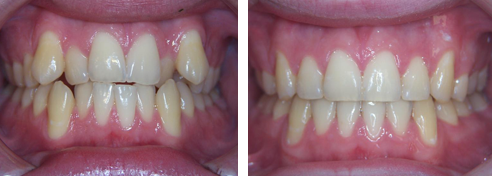What you need to know about Braces
Contents
A dental brace is a device that is used to correct crooked or overcrowded teeth and gaps between the teeth. They can also be used to correct a misaligned jaw (also known as malocclusion). The goal of dental braces is the proper alignment of your teeth and jaws, which will improve the appearance of your teeth, as well as your overall oral health and the way you chew, bite, and speak. They work by exerting constant pressure over time to gradually move your teeth and jaw into alignment.
There are several types of braces, including:
- Metal braces –are the traditional braces that come to mind for most people. Metal braces are made of metal brackets and an archwire is used to put pressure on your teeth and jawline, and O-rings are used to connect the brackets and the archwire.
- Ceramic braces – these are the same shape and size of metal braces. However, they are tooth-colored or clear, so they blend in with your teeth.
- Lingual braces – this type of braces are essentially the same as traditional metal braces, except that the wires and brackets are placed on the inside of your teeth.
- Clear aligners – mostly known as Invisalign (the most popular brand of clear aligners), these are removable, clear braces. This type of braces is best for people who only need minor corrections.
Braces are usually used during adolescence. However, more and more people are getting them later on in life.

What does the Procedure Involve?
The procedure is performed in three phases:
Initial placement of the braces
- For metal and ceramic braces: before applying the braces, your dentist will thoroughly clean your teeth. Metal bands are placed around your back molars to anchor the braces. Once the brackets and bands are firmly in place, the archwire is attached to the brackets to connect them to the bands. Finally, to secure the wire, small rubber bands are used.
- For clear aligners: your dentist will make an impression of your teeth to make sure that the clear alignment trays are perfect for your teeth on the first day of treatment.
The placement of braces is typically not painful and no anesthesia is involved.
Periodic adjustments
Your orthodontist will adjust your braces periodically by tightening or bending the wires. For clear aligners, you will be fitted for numerous versions of aligners that make a slight adjustment to move your teeth.
Retainers
To prevent your teeth from shifting back to their original position, you will need to wear retainers for a period of time to stabilize them.
How Long Should I Stay at my Destination?
Placement of braces is an outpatient procedure, so you can leave the clinic or hospital on the same day. You may be able to leave immediately after, but it is recommended that you stay for at least a week as you will experience some discomfort and you need to attend follow-up checkups.
What’s the Recovery Time?
You should be able to resume most of your normal activities the next day. However, you will experience some pain and soreness in your gums and teeth for about a week. After periodic adjustments, you may experience pain and soreness for several days.
What About Aftercare?
Your orthodontist will give you a set of instructions, including the food you should and should not eat, restrictions, how to care for your braces, and pain medications. You need to maintain good oral hygiene, during and after your treatment. Make sure to brush and floss your teeth gently to avoid damaging the brackets and wires. It is recommended that you brush after each meal. You should skip any chewy, sticky, and hard foods while you are wearing braces.
What’s the Success Rate?
The success rate of braces depends on your age when treatment begins. In general, braces are very effective for people who use them. However, adults may need to wear them longer than a younger person would. Braces are very safe, but they do carry some risks. These risks are tooth decay, gum disease, shorter root length, and loss of correction.
Are there Alternatives to Braces Procedure?
If braces are not the ideal choice for you, you can choose the alternatives, including:
- Retainers – if you only need minor correction, you can use retainers to achieve minimal tooth movement.
- Headgear – if you have an extreme overbite, headgear can be an option.
- Veneers – These are custom-made cells that can change the color, shape, size, and length of the teeth.
What Should You Expect Before and After the Procedure
Before wearing braces, your teeth and/or jaw may be misaligned, or you may have overcrowded or crooked teeth. After your braces are removed, you will have straight teeth. Having straight teeth will improve your appearance, your health, as well as the way you speak, chew, and bite.
For an in-depth analysis of a Braces Procedure, watch this short video.
To check prices or to book a Braces Procedure, in Thailand or anywhere else in the world, head on over to MyMediTravel now!

